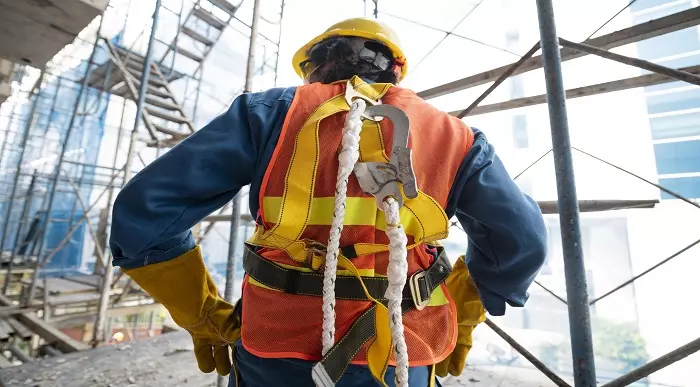Health and Safety
What Does COSHH Stand For? A Comprehensive Overview [2023]
COSHH is a collection of rules designed to keep workers safe when they’re working. Paint, bleach, and dust from natural materials are all potentially hazardous compounds. Employees, contractors, and others may be harmed as a result. For this reason, COSHH is created to safeguard, prevent, or reduce worker exposure to certain hazardous compounds.
Now, let’s elaborate on what does COSHH stands for, what does COSHH identify as hazardous substances and which of the following hazards are covered under COSHH regulations, as well as how you would apply this law.
Table of Content
What does COSHH Stand for?
COSHH stands for
C = Control
O = Of
S = Substances
H = Hazardous
H = Health
“Control of Substances Hazardous to Health”. It is a set of regulations in the UK that requires employers to control exposure to hazardous substances in the workplace to protect employees and others from harm.
Control
Control in COSHH refers to the measures employers must take to prevent or reduce exposure to hazardous substances, such as using protective equipment, implementing safe work practices, and providing training and information to employees.
Substances
Substance in COSHH refers to any chemical, dust, gas, fume, liquid or biological agent that can cause harm to human health.
Hazardous
Hazardous in COSHH refers to any substance that has the potential to cause harm to human health or the environment.
Health
Health in COSHH is refered to the physical and mental well-being of a person in relation to the potential hazards they may be exposed to in the workplace, such as exposure to hazardous substances or materials. It encompasses both short-term and long-term effects on the body and mind.
What is COSHH?
Let’s see the meaning of COSHH!
COSHH is a legal obligation. Chemical producers and suppliers show hazard signs, warnings, and safety advice for dangerous chemicals on their products. Hazardous substances must be utilised safely in the workplace and handled with caution to avoid mishaps.
If hazardous compounds are likely to be present in your workplace, you need to conduct a COSHH assessment.
Are you looking for a COSHH course?
Why is COSHH Important?
For a variety of reasons, COSHH is essential for business owners. For starters, it allows them to appropriately examine the working environment they provide to their staff, which inevitably leads to a safer workplace for employees, visitors, and members of the general public.
Millions of individuals engage in workplaces that expose them to hazardous materials, and the consequences of bad management, poor safety, and accidents can be deadly. Even exposure to dangerous working conditions can also lead to lethal diseases like asbestosis. Furthermore, Hazardous substances can also lead to occupational injury and work-related skin disorders.
Many workplaces have apparent risks, such as quarries, mines, metal finishers, woodworking and plastics manufacturers. In contrast, others, such as cleaning, construction, the automobile sector, and even food preparation, have less evident risks.
To reduce risk and harm, workplaces must provide information, training, and equipment, and employees must follow protocols so that organisations can save money and be more efficient by minimising absenteeism and not having to replace skilled staff if they follow the COSHH Regulations. A happy workforce equals a happy company.
As a result, the implementation of COSHH in an organisation is crucial.
You can check out our other blog, “What does TILE stand for? The meaning of TILE and its Usage“, to better correlate with COSHH.
What Does COSHH Cover?
Under COSHH, what is the definition of a harmful substance? That’s what we’re going to talk about now.
The hazardous substances covered by COSHH regulations include-
- Liquid
- Solid
- Fumes
- Dust
- Vapour
- Fibres
- Nano-particles
- Mists
- Gasses
- Biological agents such as germs and viruses
Damage to the lungs, skin, nose, mouth, genes, internal organs, eyes, or central nervous system is also included in the ‘hazardous’ section, as is the danger of injury from combustion or explosion.

Preparation for the CITB Health, Safety and Environment Test Online Course
- Accredited Courses
- Tutor Support Included
- 3 Installment Plan at checkout
- 14 Days Money Back Guarantee
What is COSHH Assessment?
A COSHH assessment aids in the identification of dangers and risks posed by hazardous substances in the workplace. Simply defined, it’s a comprehensive risk assessment that focuses on your workplace’s hazardous material exposure. If hazardous compounds are likely to be present in your workplace, you just need to conduct a COSHH evaluation.
A COSHH assessment consists of five steps:
- Gather information on the substances you take and how you work.
- Consider the health dangers.
- To decrease or eliminate the hazards, choose appropriate control measures.
- Make a note of your findings and put your controls in place.
- Keep track of your progress and analyse your evaluation.
COSHH in the Workplace
COSHH Regulations 2002 is a UK law that requires employers to control substances that are hazardous to health. This includes identifying the risks, providing appropriate training, and implementing measures to prevent or minimize exposure.
COSHH Laws for Employers
Employers are responsible for a number of important COSHH regulations. Among them are:
- Employers must avoid or control hazardous substance exposure. If necessary, this can include the provision of suitable personal protective equipment (PPE).
- They should execute hazardous material control measures and ensure that they are up to date, in excellent working order, and clean when necessary.
- They should provide information, guidance, and training to employees about working with dangerous substances.
- They should have procedures in place to deal with hazardous substance incidents and emergencies.
- They have to ensure that employees who are exposed to dangerous substances are properly monitored.
- They should carry out COSHH risk evaluations.
- They should ensure that hazardous compounds aren’t used in excess of the Workplace Exposure Limit (WEL).
- They should keep an eye on the employees to ensure that they are doing their jobs correctly.
COSHH Laws for Employees
Employees are responsible for ensuring that jobs are completed safely to avoid danger to themselves or others. Among them are:
- Employees should assist their coworkers in establishing a secure working environment. This can include assisting coworkers in adhering to their workplace’s rules and laws.
- They must follow the measures in place to prevent mishaps and overexposure to PPE (personal protective equipment). They have to put on the proper PPE, including eye and hearing protection. This involves ensuring that all PPE is stored correctly in the appropriate location.
- They must keep track of all accidents, spills, and breaks.
- When necessary, they have to go to medical check-ups.
- They must follow established procedures when using cleaning and showering facilities provided by employers.
- They have to stay updated with employer-provided training.
What are the 8 Principles of COSHH?
So, what is COSHH regulations?
As per the Health and Safety Executive, the “8 Principles of Good Practice” are included in the COSHH regulations 2002. Firms must adhere to these principles in order to reduce workplace risk and comply with legislation.
The following are the 8 Principles of Good Practice:
- Through carefully structured processes and actions, reduce the emission and spread of dangerous substances.
- Consider all possible routes of exposure when creating COSHH control measures, including inhalation, skin absorption, and ingestion.
- Control exposure levels with measures that are proportional to the health threat
- Choose the most efficient and reliable control mechanisms to prevent dangerous substances from leaking and spreading.
- If alternative methods fail to offer adequate exposure control, appropriate personal protective equipment must be provided and utilised in conjunction with other control measures.
- COSHH testing should be used to monitor and review the effectiveness of control measures on a regular basis to ensure their continued effectiveness.
- All personnel must be aware of the hazards and risks involved with the substances with which they operate, as well as adequately trained in the application of risk-reduction techniques.
- Ascertain that implementing controls does not enhance the overall risk to health and safety.
Besides, you can visit our other blog, “What is the Purpose of a Risk Assessment?”
COSHH Symbols and Meanings
This section will describe the symbols of COSHH signs, which consist of nine major hazard symbols. While some of these symbols and signs are self-explanatory or have clear meanings, some require more explanation:
Explosives (Symbol: Bomb Exploding)
Chemicals, compounds, and any occupational incident that could create an explosion are classified as explosives. An exploding bomb is represented by the symbol. It is linked to a number of things:
- Hazard of mass explosion
- Risk of severe projection
- Hazards of fire, blast, or projection
- A massive explosion of fire
- Unstable detonation
Flammable (Symbol: Open Flame)
This sign denotes any flammable chemicals or other substances that can ignite when exposed to air, have a small source of ignition, have a low flash point, or produce highly flammable gases when exposed to water. A big open flame serves as the symbol.
- Gases
- Aerosol
- Liquids and vapours that are highly flammable
- A flammable substance
Oxidiser (Symbol: Open Flame Over a Circle)
Compounds that can cause a harmful interaction with other chemicals during their manufacture are classified as oxidising. This COSHH hazard symbol shows a flame above a circle that represents this COSHH hazard.
- Increases the intensity of the fire by acting as an oxidiser.
- It has the potential to operate as a strong oxidiser, resulting in a fire or explosion.
- Bleach frequently contains the chemical.
Compressed Gas (Symbol: Gas Cylinder)
This symbol depicts a picture when gas is under pressure. It’s also an example of a hazard that’s been recently added to the COSHH classification system. A gas cylinder is represented by the symbol.
- When heated, gas under pressure could explode
- Cryogenic injuries can be caused by refrigerated gas.
- The emblem is commonly seen on gas canisters.
Corrosive (Symbol: Corrosion on Hands and Surface)
The corrosive sign warns people about chemicals that can harm living tissue when they come into touch with them. The image depicts a chemical leak corroding a hand and a surface substance.
- Metals are susceptible to corrosion.
- Skin and eye damage are possible side effects.
- Ammonia, acetic acid, hydrochloric acid, drain cleaners, and other chemicals contain it.
Toxic (Symbol: Skull and Crossbones)
The toxic symbol denotes compounds that can cause significant harm, even in small or extremely small amounts. There are symbols of skull and crossbones.
- When ingested, breathed, or in contact with skin, it can be lethal.
- If consumed, breathed, or in contact with skin, it can be harmful.
Warning (Symbol: Exclamation Mark)
The health hazard sign denotes substances that may be harmful to one’s health. The emblem also denotes a warning to be cautious.
- Irritation of the respiratory tract
- Dizziness and/or drowsiness are possible side effects.
- Allergic responses are possible.
- May cause severe eye discomfort.
- Skin inflammation is possible.
- If absorbed, it may cause harm. If it comes into touch with the skin, it may cause harm.
- Damage to the ozone layer may endanger public health.
Top Courses of this Category
Long-term Health Hazards (Symbol: Internal Damage)
The icon denotes substantial long-term health risks. The illustration on the sign depicts a person with internal injuries.)
- If ingested or inhaled, it can be fatal.
- Organ damage is possible.
- Can affect fertility and cause miscarriages
- Can cause cancer
- Can cause genetic abnormalities
- Can cause asthma or breathing problems.
Danger to the Environment (Symbol: A Dead Tree and Dead Fish)
This sign denotes the danger of compounds that could harm various components of the environment in the short or long term. There are a dead tree and a dead fish depicted in the symbol.
- Toxic to marine life with long-term consequences
- Pesticides, biocides, fuel, and turpentine are some of the most common examples.
Why it is Vital to Understand the COSHH Symbols in Terms of Health and Safety?
Learning the COSHH symbols is essential for ensuring that you and your staff are aware of the hazards that exist in your workplace. Understanding the new COSHH symbols can help you comply with health and safety laws while also reducing the number of incidents that occur in your workplace.
COSHH Training Online
COSHH training is essential for anyone who works with hazardous substances. Lead Academy provides Control of Substances Hazardous to Health COSHH Training Course Online. By taking this training, you will learn how to identify, assess, and control the risks associated with these substances, ensuring that you can work safely and effectively
Conclusion
In essence, we strongly advise that companies create a safe working environment for their employees. Because they are a company’s greatest assets, their happiness will undoubtedly elevate your company’s status to new heights. As an employer, it is your responsibility to protect your employees from harmful substances.
So it’s your duty to bring COSHH into your organisation’s total picture, introduce “What does COSHH stand for” and apply it with care. To do so, you’ll need to do a COSHH assessment.
FAQs
How many steps are there to COSHH compliance?
There are four main steps to COSHH compliance: identifying the hazards, assessing the risks, controlling the risks, and monitoring and reviewing the effectiveness of those controls.
Which of the following hazards are covered under COSHH regulations?
COSHH regulations cover hazards such as chemicals, dusts, fumes, biological agents, and substances that can cause skin irritation or damage. It is important for employers to assess the risks associated with these hazards and implement control measures to minimize exposure and protect the health and safety of their employees.
What does COSHH identify as hazardous substances?
COSHH identifies hazardous substances as any substance that has the potential to cause harm to health, including those that are harmful to the environment. Further, examples of hazardous substances include chemicals, fumes, dusts, vapors, gases, biological agents, and nanomaterials.
What foods can irritate the lungs COSHH?
If considered COSHH foods like spices, strong-smelling foods, and foods that produce fumes or smoke when cooked can irritate the lungs. It is important to take necessary precautions and follow safety guidelines when handling and cooking these types of foods.
Is lead covered by COSHH?
Foods that can irritate the lungs include spicy foods, dairy products, and processed foods. COSHH regulations cover a wide range of hazardous substances, but lead is specifically covered under the Control of Lead at Work Regulations.
What are COSHH responsibilities?
COSHH responsibilities include ensuring that hazardous substances are properly labeled and stored, providing appropriate training to employees who handle such substances, and implementing measures to prevent exposure and accidents.” It is also important to regularly review and update risk assessments and control measures.
What do COSHH symbols mean?
Each COSHH danger symbol denotes the presence of a separate hazard, such as corrosiveness, environmental toxicity, or serious health risks if handled improperly.
How do you identify a hazardous substance?
You’ll frequently find COSHH symbols on product labels, indicating whether or not they are dangerous. However, recognising a dangerous substance isn’t always as simple as looking through product labels.
When did the UK introduce COSHH?
COSHH regulations developed from an earlier piece of legislation, first introduced in 1988, with the goal of focusing more attention on the dangers of hazardous substances and the precautions taken by employers to control and mitigate risks.
What does WEL stand for in COSHH?
WEL stands for Workplace Exposure Limits. A simple Google search will give you a list of substances which have a WEL regulation tied to them.
What to Read Next:











